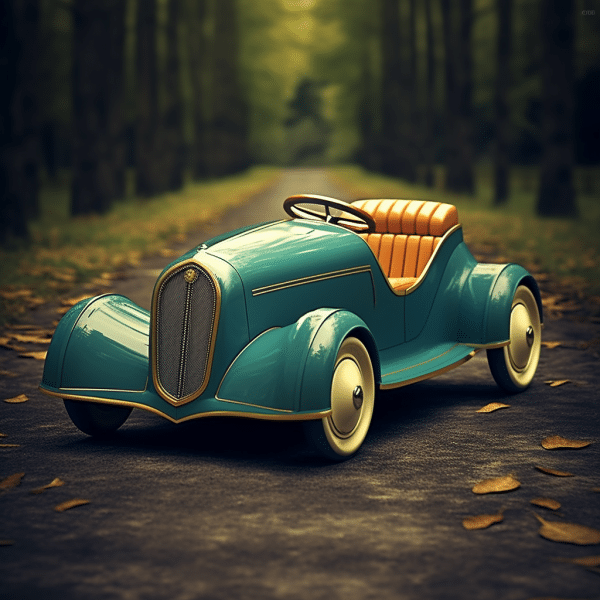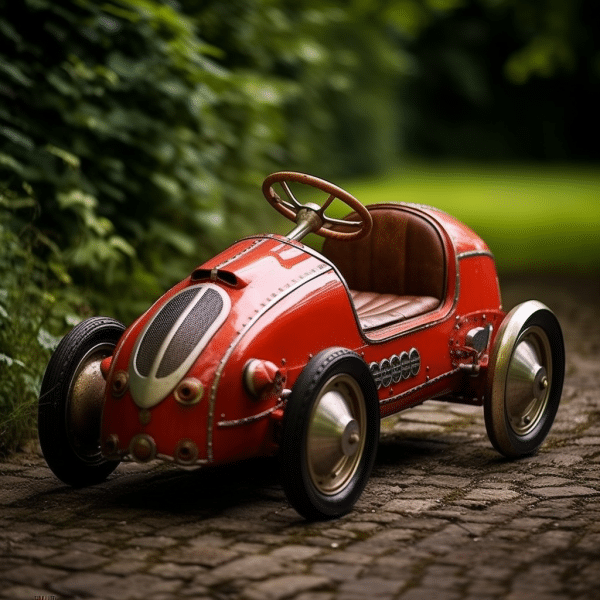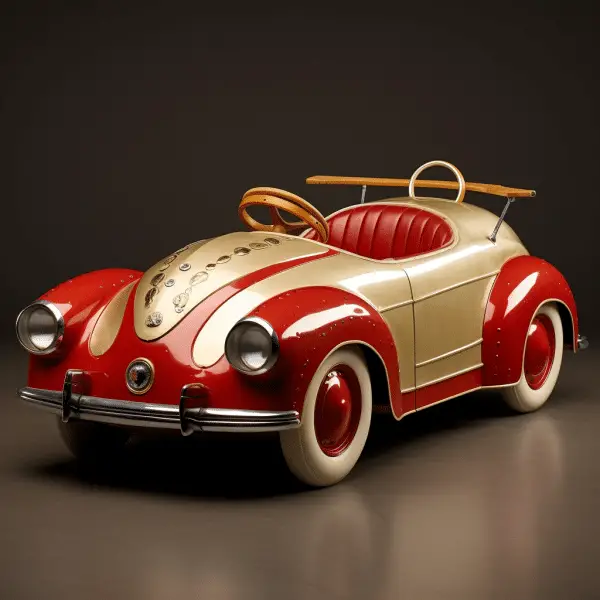
Exploring the Fascinating World of Vintage Pedal Cars

Introduction to Vintage Pedal Cars
Vintage pedal cars lend a special spirit to collectors and enthusiasts. These mini vehicles, crafted with close attention to detail, evoke nostalgia for an earlier era. From a ’30s roadster’s sleek lines to a ’50s fire truck’s charming design, these pedal-powered wonders capture imaginations and transport us back to a time when childhood adventures were powered only by pedals.
We must understand their importance in history and culture. These toys weren’t just playthings; they showed an extension of grown-up transport, permitting children to imitate their parents as they explored imaginary roads and make-believe landscapes. Pedal cars were crafted with skill, boasting working headlights, adjustable pedals, and even functional steering.
Vintage pedal cars act as time capsules, preserving history in their frames. Models may bear ads or company logos from the era, letting collectors unlock social insights from the past.
Personal stories bring the true magic of vintage pedal cars to life. Take Henry Johnson, who found his childhood pedal car while sorting out his dad’s attic. Memories flooded back – afternoons spent zooming down sidewalks, laughter echoing through streets, and dreams soaring with the wheels. Suddenly, it wasn’t a toy; it was a beloved link to a straightforward time.
Let us explore the world of vintage pedal cars, where the past and the present collide. With each turn of the wheel, we find stories to uncover. We can marvel at the various designs, incredible craftsmanship, and captivating tales. This enchanting realm sparks our imaginations and reminds us of the magic of childhood. Identifying vintage pedal cars may not be as thrilling as solving a murder, but it’s the closest some will get to feeling like a detective.
Importance of Identifying Vintage Pedal Cars
To accurately identify vintage pedal cars and assess their value, understanding the key features is crucial. Exploring the importance of identifying vintage pedal cars in the realm of collectibles, we dive into the sub-section discussing the key features.
Key Features of Vintage Pedal Cars
Vintage pedal cars have a special charm. From the intricate designs and curves to the grille work, these cars are elegant and stylish. Unlike plastic toys, they are made of high-quality materials such as metal and rubber tires – making them sturdy and durable.
They also have amazing features like a functioning steering wheel, allowing kids to steer the car. Plus, they have a pedaling mechanism so kids can pedal it forward or backward.
These cars are often adorned with intricate decals, chrome accents, and working parts such as headlights or hoods that open and close. It’s believed the first vintage pedal car was produced in the late 19th century, and since then they’ve become sought-after collector’s items.
These miniature vehicles transport kids back in time while still providing joy and entertainment. They have the ability to captivate with their unique features and timeless design.
Common Characteristics of Vintage Pedal Cars
To better understand the common characteristics of vintage pedal cars, delve into the world of these nostalgic gems. Discover various types of vintage pedal cars, each with its own unique allure and charm. Uncover the secrets and details that make these classic rides a collector’s dream.
Types of Vintage Pedal Cars
Text: Vintage pedal cars – ah, the memories! Various types exist, each with unique characteristics. In the past, these pedal-powered vehicles were popular amongst children for transportation. Let’s check out the different types and their features!
Classic cars like the Ford Model T, Chevrolet Bel Air, and Cadillac Eldorado had pedal car versions. Fire trucks, police cars, and race cars inspired by Ferrari and Porsche too! Plus, Disney character-themed models and ones based on cartoons added an element of fun.
There were planes and helicopters – wings and movable propellers – to inspire imaginative play. And functionality such as working headlights and sound effects enhanced the realism and authenticity.
The early 20th century saw the rise in popularity of these pedal cars, due to the automobile culture. Families wanted affordable toys for their kids, so miniature versions were created for them to explore.
Finding vintage pedal cars can be a challenge. But with the right tools, you’ll discover nostalgic treasures!
Methods for Identifying Vintage Pedal Cars
To identify vintage pedal cars, utilize methods such as researching pedal car manufacturers, examining design elements and materials, and identifying vintage pedal car markings and labels. These approaches provide solutions to identifying the origins and authenticity of vintage pedal cars, aiding collectors and enthusiasts in their quest for accurate information.
Researching Pedal Car Manufacturers
Researching pedal car manufacturers requires gathering info on different brands and their past. Examine vintage catalogs, ads, and online forums to uncover details about the origins and production of these collectible toys.
Check out this table for key info on popular pedal car manufacturers:
| Manufacturer | Year Established | Notable Models |
|---|---|---|
| Garton | 1887 | Kidillac, Super Sonda |
| Murray | 1910 | Comet Fire Chief, Sadface |
| Steelcraft | 1920 | Chrysler Airflow, Roadster |
| Hamilton Metal | 1930 | Sky King, Pursuit Plane |
| AMF | 1949 | Fire Fighter, Junior Mustang |
When researching vintage pedal cars, pay attention to distinctive details like logo designs or design elements. These clues can help identify the exact era a particular model was made. Plus, collector websites and enthusiast groups provide valuable insights from experienced pedal car aficionados.
Researching pedal car manufacturers also reveals the historical importance of their creations. For example, Murray was renowned for its quality builds and their ability to adapt to the times. After WWII, they shifted from making bicycles to producing pedal cars, becoming a leading brand.
Use these research methods and learn the history of pedal car manufacturing. You’ll gain a better understanding of each manufacturer’s contribution to this beloved hobby. So, get ready to embark on an exciting journey and bring nostalgic joy to your collection!
Examining Design Elements and Materials
Design elements and materials can help uncover the secrets of vintage pedal cars. By examining their features and construction materials, collectors and enthusiasts can gain insight into their origins and context.
Below is a table with key design elements and materials found in vintage pedal cars:
| Design Element | Description |
|---|---|
| Body Shape | Classic pedal cars often feature unique body shapes, like aerodynamic designs or mini-replicas of cars. |
| Paint Finish | The paint finish can range from vibrant and glossy to faded and weathered. It depends on the age and condition of the toy. |
| Materials | Pedal cars were usually made from strong materials like steel or heavy gauge pressed metal for the body. Smaller elements like headlights could be plastic or glass. |
| Decals/Emblems | Often, pedal cars featured decals or emblems from real car makers. This added authenticity to their design. |
| Wheels | Vintage pedal cars typically had rubber tires with metal rims for a smooth ride and great look. |
Unique details like intricate steering wheel or dashboard detail, functional pedals or levers, adjustable seats, working headlights and taillights, and license plates can help determine the authenticity, value, and rarity of a model.
Manufacturing techniques in the early 20th century helped mass-produce these cars at affordable prices. This made them popular with children and collectors.
By looking at design elements and materials, enthusiasts can learn the stories behind these beloved toys and appreciate their historical importance. So, use your detective skills to uncover the hidden mysteries of vintage pedal cars!
Identifying Vintage Pedal Car Markings and Labels
Vintage pedal cars have unique markings and labels that can help enthusiasts identify their origins and historical significance. These telltale signs provide valuable clues for collectors and historians to trace the lineage of these miniature vehicles.
Manufacturer’s imprints, model numbers, decals, stickers, patent information, country of origin, and materials used can all help uncover fascinating stories from yesteryears.
These markings serve as a window into a bygone era, and understanding their context can provide insight into societal trends and cultural influences.
To get the most out of vintage pedal cars, experts recommend consulting reputable guides such as “Vintage Pedal Cars: A Guidebook” by John G. Smith. It offers in-depth information on identifying markings, history, and restoration techniques.
Uncovering the truth behind vintage pedal cars is like solving a mystery – but with detective skills and a quick wit!
Tips for Authenticating Vintage Pedal Cars
Text: Vintage pedal cars are highly prized by collectors and enthusiasts alike. Authenticating these vintage gems is essential to maintain their value and legitimacy. Here are some helpful hints to keep in mind:
- Inspect the materials. Check the body, wheels, and steering of the car. Usually, authentic vintage models are made of strong metal rather than plastic.
- Look for originality. See if there are unique features like labels or markings that show authenticity. Research reputable brands and compare them to your findings.
- Evaluate age and condition. Vintage pedal cars can range in age, so it’s important to understand when they were produced. Consider wear, rust, and restoration work.
Other helpful details for authenticating vintage pedal cars:
Research historical accuracy. Learn about design trends and themes from various eras and see if the pedal car fits.
Check documentation. Original paperwork can raise the authenticity. Look for receipts, manuals, or past ownership records.
Pro Tip: When unsure, reach out to experts or appraisal services. Their expertise and experience offer valuable insight into the car’s true origin.
Collecting and Preserving Vintage Pedal Cars
To ensure the proper collecting and preserving of vintage pedal cars, grasp the section on “Collecting and Preserving Vintage Pedal Cars” with an exploration of “Best Practices for Displaying and Storing Vintage Pedal Cars” as the solution.
Best Practices for Displaying and Storing Vintage Pedal Cars
Showcasing vintage pedal cars? Here’s what to keep in mind!
- Choose a place with minimal sun exposure – like a display case or shelf.
- Clean them regularly, using only soft cloths.
- Rotate the display to evenly distribute light.
- When handling them, use white gloves to avoid transferring oils.
- Use acid-free archival materials for any documentation.
- For an extra touch, include relevant memorabilia or period-appropriate decor.
Now you’re ready to show off your collection!
Resources for Vintage Pedal Car Identification
To identify vintage pedal car, you can rely on valuable resources such as online pedal car communities and forums, as well as pedal car identification guides and books. These resources offer a wealth of knowledge and insights from enthusiasts and experts, allowing you to gain a better understanding of the intricacies and unique characteristics of vintage pedal car.
Online Pedal Car Communities and Forums
Members often post pics of their collections or new finds, which leads to lots of chats.
Novices can get help from experienced members who are happy to share their knowledge.
Questions about identifying models or parts can be asked on forums.
Collectors can also trade and sell pedal cars amongst themselves, for expanding their collections.
Platforms enable enthusiasts to learn about upcoming vintage events and swap meets.
Plus, some forums organize virtual shows where members show their collections with pics and videos.
Not just vintage pedal car fans can join these online communities. Discussions about modern toy cars provide a place for all toy car lovers to join and share.
It’s impressive that some online pedal car communities have been around for more than two decades! For instance, “Pedal Car Planet” forum was established in 1999 and still continues to be a great hub for pedal car lovers.
Identifying the right era for pedal cars is made easier with these guides and books. This way, you can avoid accidentally peddling through someone’s mid-life crisis!
Pedal Car Identification Guides and Books
For pedal car enthusiasts, identification guides and books provide vital info. They have detailed descriptions, illustrations, and photos of various models. This helps collectors figure out the make, model, and era of their pedal cars.
The tables in these guides show the manufacturer’s name, production years, features, and any unique details of the pedal car models. So collectors can easily compare different models and spot distinguishing features.
One cool thing these resources cover is the evolution of pedal car designs over time. You’ll see shifts from classic styles to automobile-inspired designs. This knowledge lets you accurately date and classify your vintage pedal car collection.
Pro Tip: Cross-reference multiple resources for accuracy. Some books may have more info or focus on specific makers or eras. Now go have fun with your pedal car!

Conclusion: The Value of Identifying and Appreciating Vintage Pedal Car
Vintage pedal cars are beloved by enthusiasts and collectors. They give us a glimpse of the past, and celebrate craftsmanship and imagination.
These vehicles conjure fond memories of simpler times, when play was all that mattered. When we identify vintage pedal car, we get insight into the history of toy-making. We can admire the intricate designs, hand-painted details, and authentic materials.
Appreciating these car preserves an important part of our cultural heritage. Each one carries a story from the past, with adventure and exploration. Acknowledging their significance ensures future generations will still be captivated.
The features of vintage pedal car have loads of memories behind them. Unique custom paint jobs or rare models add to our understanding. Each car is different, making discovery a journey.
The Pedal Car Museum in Colorado holds the world’s largest collection of vintage pedal car. It shows the mastery behind each car, and the variety of designs from different eras.
So next time you come across one of these cars, take a moment to appreciate its beauty and historical meaning. You might find a piece of craftsmanship which transports you back in time – with joy and connection to our past.
